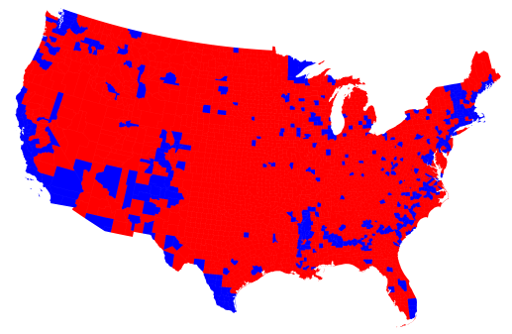The opponents of the Electoral College, in attempting to undermine support for the institution, have painted it with an unfair half-truth.
Let's Imagine 2016 without the Electoral College
The Electoral College has long been the strange uncle of the American Constitutional order—little understood and even less appreciated. But there is a reason that hundreds of amendments have been submitted to change the system and none of them have come even close to passage in more than forty years: it works!
Tensions haven’t been this high in a post-election America since rumors circulated that President-elect Thomas Jefferson was coming to confiscate Bibles. Still, despite the tension and near depression among so many disappointed millennials, the Electoral College worked to give us a president-elect who is among the most controversial in history, but whose legitimacy is not seriously in question. And, the election was conducted across the country with strong participation of every demographic and ideology across the spectrum. The Electoral College did its job. But, let’s imagine 2016 without the Electoral College.
Imagine two candidates simply vying to achieve one more popular vote than their opponents and ending up separated by only 150,000 or so votes. That’s only a vote or two per precinct from Maine to San Diego. Now imagine a candidate who thought the system was “rigged” and who had potentially hundreds of millions of dollars that could be spent on lawyers and with agitated supporters to encourage him. Imagine the recounts and vote challenges happening in every precinct in every county in every state across the union; minority votes discarded, military mail in votes disqualified and a national nightmare dragging on for weeks.
Imagine an election being run where the Democratic candidate could count on automatically getting 35 percent or so of the vote without doing anything but who could then get tens of millions of votes representing the margin of victory simply from settling down into major urban areas like Philadelphia, LA, Chicago, New York, San Francisco, and driving up massive voter turnout there. Would Hillary Clinton have ever talked to a western Pennsylvania steel worker or a North Carolina farmer?
Imagine life without the Electoral College’s winner-take-all system in the states. This is what drives the two major parties into broad, moderate coalitions that add stability to our electoral politics and our government. Without the need to win entire states, there would be no incentive left for people like John Kasich or Ted Cruz or Bernie Sanders to leave the race. Rather, America’s natural four party system would be on display with Cruz taking the right, Sanders taking the left, and Clinton, Trump and Kasich sucking up the rest.
Now imagine none of those candidates getting more than thirty percent of the vote. Is that enough to elect a president of the United States? Would twenty five percent be enough? Do we want a president who seventy percent of the American people voted against? If not, then we would have to establish a run-off system and a second election. Who besides the television ad salesmen want to go through a second national election with our living rooms being bombarded by negative ads?
2016 was an ugly election, but it was not because of the Electoral College. Rather, the Electoral College gave us a race fought in major cities and rural areas with the winner taking states in the south, rustbelt and west and the loser conceding in a timely manner and without any legal trials or serious controversy. We have a legitimate president-elect and will have an uncontroversial transfer of power in January. You can’t ask for much more than that in any electoral system.

